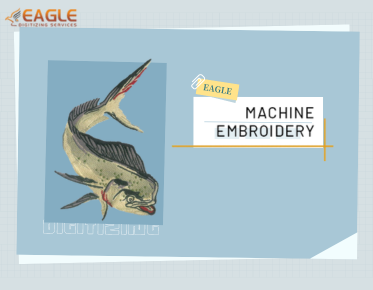Inside the Embroidery Industry: Key Players, Market Dynamics, and Trends
Introduction to the Embroidery
Industry
The embroidery industry is a dynamic and
multifaceted sector that encompasses a wide range of businesses and
professionals involved in the design, production, and distribution of
embroidered goods. From traditional hand embroidery to modern digital
techniques, the industry has evolved significantly over the years, driven by
technological advancements, changing consumer preferences, and emerging market
trends.
Key Players in the Embroidery Industry
Embroidery Machine Manufacturers
Embroidery machine manufacturers play a
crucial role in the industry by producing state-of-the-art equipment that
enables businesses to create high-quality embroidered products efficiently and
cost-effectively. Companies like Tajima, Barudan, and Brother are among the
leading manufacturers, offering a diverse range of machines tailored to the
needs of different businesses, from small-scale operations to large-scale
production facilities.
Embroidery Thread and Supplies Companies
Embroidery thread and supplies companies are
essential suppliers to the industry, providing a wide range of threads,
stabilizers, and other materials necessary for embroidery production. Brands
such as Madeira, Coats, and Robison-Anton are renowned for their high-quality
products and extensive color ranges, catering to the diverse needs of
embroiderers across the globe.
Embroidery Digitizing Services Providers
Embroidery digitizing services providers play
a critical role in the industry by transforming artwork or designs into digital
embroidery files that can be read and interpreted by embroidery machines. Embroiderydigitizing companies employ skilled digitizers and advanced software to create
precise stitch files that ensure the accurate reproduction of designs on a
variety of materials.
Embroidery Design Software Developers
Embroidery design software developers develop
innovative software solutions used by professionals in the industry to create,
edit, and customize embroidery designs. Companies like Wilcom, Pulse, and Hatch
by Wilcom offer powerful software tools that enable users to unleash their
creativity and produce stunning embroidery designs with ease.
Market Dynamics of the Embroidery Industry
Global Market Size and Growth Trends
The embroidery industry is experiencing steady
growth on a global scale, driven by factors such as increasing demand for
customized and personalized products, technological advancements in embroidery
machinery, and the growing popularity of embroidery in various sectors such as
fashion, apparel, and home decor.
Regional Market Analysis
The embroidery industry is geographically
diverse, with key markets in regions such as North America, Europe, Asia
Pacific, and Latin America. Each region has its own unique market dynamics,
influenced by factors such as consumer preferences, economic conditions, and
cultural influences.
Factors Driving Market Growth
Several factors are driving the growth of the
embroidery industry, including the growing demand for customized and
personalized products, advancements in embroidery technology, the rise of
e-commerce platforms and online marketplaces, and increasing consumer interest
in embroidered apparel, accessories, and home decor items.
Challenges and Opportunities
While the embroidery industry presents
significant opportunities for growth and innovation, it also faces challenges
such as intense competition from digital printing and other decoration methods,
rising labor costs and skilled labor shortages in some regions, and the need to
adapt to changing consumer preferences and market trends. However, these
challenges also present opportunities for businesses to differentiate
themselves through product diversification, value-added services, and
innovation in design and production processes.
Trends Shaping the Embroidery Industry
Technological Advancements in Embroidery Machinery
Technological advancements in embroidery
machinery are revolutionizing the industry, enabling businesses to achieve
higher levels of efficiency, precision, and productivity. Features such as
multi-head machines, automatic thread tensioning, and laser guidance systems
are increasingly being adopted by businesses to streamline their operations and
meet the growing demand for customized and personalized products
Growing Demand for Customization and Personalization
There is a growing trend towards customization
and personalization in the embroidery industry, driven by consumer preferences
for unique and one-of-a-kind products. Businesses are offering customembroidery services that allow customers to personalize their clothing,
accessories, and promotional items with names, logos, and designs of their
choice. This trend is particularly evident in the fashion and apparel industry,
where consumers are seeking personalized garments that reflect their individual
style and identity.
Sustainability and Eco-Friendly Practices
With increasing awareness of environmental
issues and sustainability concerns, there is a growing emphasis on eco-friendly
practices in the embroidery industry. Companies are adopting sustainable
materials and production methods, such as using organic and recycled threads,
reducing water and energy consumption, and implementing waste reduction and
recycling programs. Consumers are also increasingly seeking out eco-friendly
embroidery products that align with their values and commitment to
sustainability.
Integration of Embroidery in the Fashion and Apparel Industry
Embroidery is becoming increasingly integrated
into the fashion and apparel industry, with designers and brands incorporating
embroidered elements into their collections. From delicate floral motifs to
bold logos and embellishments, embroidery adds texture, dimension, and visual
interest to garments, making them stand out in a crowded marketplace.
Embroidered denim, jackets, dresses, and accessories are particularly popular,
offering a unique and artisanal touch to fashion-forward consumers.
Future Outlook and Projections for the Embroidery Industry
Emerging Markets and Opportunities
The embroidery industry is poised for
continued growth and expansion, with emerging markets such as Asia Pacific, the
Middle East, and Africa presenting significant opportunities for investment and
development. Rising disposable incomes, increasing urbanization, and growing
consumer demand for customized and personalized products are driving demand for
embroidery across various sectors, including fashion, apparel, home decor, and
promotional merchandise.
Innovations in Embroidery Techniques and Materials
Innovation is key to driving growth and
competitiveness in the embroidery industry, with companies investing in
research and development to develop new techniques, materials, and
technologies. From innovative stitching methods to novel materials such as
conductive threads and smart textiles, there is no shortage of opportunities
for innovation and creativity in the embroidery industry. Businesses that stay
ahead of the curve and embrace new technologies and trends will be
well-positioned to capitalize on emerging opportunities and maintain a
competitive edge in the market.
Impact of Digitalization and Automation
Digitalization and automation are reshaping
the embroidery industry, enabling businesses to streamline their operations,
improve efficiency, and reduce costs. From automated digitizing software to
robotic embroidery machines, digital technologies are revolutionizing every
aspect of the embroidery process, from design creation to production and
fulfillment. By embracing digitalization and automation, businesses can
increase productivity, enhance quality, and meet the growing demand for
customized and personalized products in an increasingly competitive
marketplace.
Predictions for Market Growth and Evolution
Looking ahead, the future of the embroidery
industry looks bright, with continued growth and innovation expected in the
coming years. Technological advancements, changing consumer preferences, and
emerging market trends will drive market growth and evolution, creating new
opportunities and challenges for businesses in the industry. By staying abreast
of market trends, investing in innovation, and adapting to changing consumer
demands, businesses can position themselves for success in the dynamic and
ever-evolving landscape of the embroidery industry.
Conclusion: Navigating the Evolving Landscape of the Embroidery Industry
As the embroidery industry continues to evolve
and adapt to changing market dynamics and consumer preferences, businesses and
professionals must stay informed and proactive to seize opportunities and
overcome challenges. By embracing technological advancements, exploring new
trends, and fostering innovation and creativity, the embroidery industry can
thrive in a competitive global marketplace, delivering unique and high-qualityembroidered productshigh-quality
embroidered products
.png)


